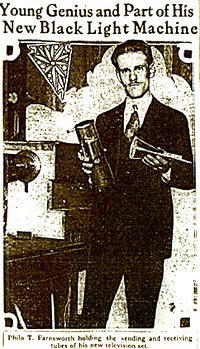S.F. Man's Invention to Revolutionize Television
NEW PLAN BANS ROTATING DISC IN BLACK LIGHT
W.W. Crocker, R.N. Bishop Head Local Capitalists Backing Genius
 Two major advances in television were announced yesterday by a young inventor who has been quietly working away in his laboratory in San Francisco and has evolved a system of television basically different from any system yet in operation.
Two major advances in television were announced yesterday by a young inventor who has been quietly working away in his laboratory in San Francisco and has evolved a system of television basically different from any system yet in operation.
The inventor is Philo T. Farnsworth, and local capitalists, headed by W.W. Crocker and Roy N. Bishop, are financing the experiments and have aided him in obtaining basic patents on the system.
In any method of transmitting moving images at a distance, some means must be evolved of breaking the image into pin points of light. These points are translated into electrical impulses, the electrical impulses are collected at the receiving end and translated back into light, and the image results.
NEW PRINCIPLE APPLIED
All television systems now in use employ a revolving disc, two feet in diameter, to break up or "scan" the image. A similar disc is at the receiving end, and the two discs must revolve at precisely the same instant and at precisely the same speed or blurred vision results.
Farnsworth's system employs no moving parts whatever. Instead of moving the machine, he varies the electric current that plays over the image and thus gets the necessary scanning.
The system is thus simple in the extreme, and one of the major mechanical obstacles to the perfection of television is thereby removed.
It was through this simplicity that he achieved his second greatest advance, the cutting in half of the wave band length necessary to prevent television broadcasts interfering with each other. The importance of this is manifest, inasmuch as it requires approximately four times the wave band length for television that ordinary sound broadcasting requires. Farnsworth has cut this television wave band in half and is hoping for still further reduction.
PERFECT MOTION RECORDS
His system sends twenty pictures per seconds, so motion is perfectly recorded, and there are 8000 elements, or pin points of light, in each picture to insure detail. The laboratory model he has built transmits the image on a screen one and one-quarters inches square. It is a queer looking little image in bluish light now, one that frequently smudges and blurs, but the basic principle is achieved and perfection is now a matter of engineering.
The sending tube which is the heart of Farnsworth's transmitting set is about the size of an ordinary quart jar that a housewife uses for preserving fruit, and the receiving tube containing the screen is even smaller. Farnsworth estimates the receiving apparatus could easily be attached to an ordinary radio set and can be manufactured to retail at $100 or less.
Farnsworth is a native of Provo, Utah, and conceived the idea for his television set while a student at Brigham Young University there. He was discovered by George Everson and Leslie Gorrell, who brought the set to the attention of research engineers at the California Institute of Technology. These experts pronounced it workable and helped Farnsworth obtain the financial backing. The research laboratories are at 202 Green street.
I got this article from some fabulous librarians in San Fran and sent it to Jane and Joe... should have sent it to the whole cast. Thanks to Jim for correcting my oversite.
ReplyDelete